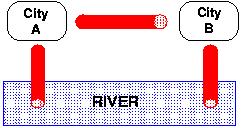POJ 1205 Water Treatment Plants(递推)
题意 建设一条河岸的污水处理系统 河岸有n个城市 每一个城市都能够自己处理污水 V 也能够把污水传到相邻的城市处理 >或< 除了你传给我我也传给你这样的情况 其他都是合法的 两端的城市不能传到不存在的城市
令d[i]表示有i个城市时的处理方法数 最后一个城市的处理方法有
1.V 自己处理自己的 与前i-1个城市的处理方法无关 有d[i-1]种方法
2.< 给左边的城市去处理 也与前i-1个城市的处理方法无关 把自己的污水给第i-1个城市即可了 有d[i-1]种方法
3.>V 左边有污水传过来 和自己的一起处理 这时第i-1个城市能够向右传了 假设这样的情况发生的话 那么第i-1个城市肯定不可能是向左传的 但前i-2个城市的处理方法没有影响 所以第i-1个城市向左传的方法有d[i-2]种 然后第i-1个城市不向左传就有d[i-1]-d[i-2]种方法了
所以有递推公式d[i]=3*d[i-1]-d[i-2];
增长速度非常快要用大数处理 大数就用java了
import java.util.*;
import java.math.*; public class Main {
public static void main(String args[]) {
Scanner in = new Scanner(System.in);
BigInteger d[] = new BigInteger[105];
d[1] = BigInteger.ONE;
d[2] = BigInteger.valueOf(3);
for (int i = 3; i <= 100; ++i)
d[i] = d[i - 1].multiply(d[2]).subtract(d[i - 2]);
while (in.hasNext())
System.out.println(d[in.nextInt()]);
in.close();
}
<span style="font-family:Microsoft YaHei;">}</span>
还有没加大数模版的c++代码
#include<cstdio>
#include<cstring>
using namespace std;
const int N = 105;
int main()
{
int d[N] = {0, 1, 3}, n;
for (int i = 3; i <= 100; ++i)
d[i] = 3 * d[i - 1] - d[i - 2];
while (~scanf ("%d", &n))
printf ("%d\n", d[n]);
return 0;
}
Description
comming from cities before being discharged into the river.
As part of a coordinated plan, a pipeline is setup in order to connect cities to the sewage treatment plants distributed along the river. It is more efficient to have treatment plants running at maximum capacity and less-used ones switched off for a period.
So, each city has its own treatment plant by the river and also a pipe to its neighbouring city upstream and a pipe to the next city downstream along the riverside. At each city's treatment plant there are three choices:
- either process any water it may receive from one neighbouring city, together with its own dirty water, discharging the cleaned-up water into the river;
- or send its own dirty water, plus any from its downstream neighbour, along to the upstream neighbouring city's treatment plant (provided that city is not already using the pipe to send it's dirty water
downstream); - or send its own dirty water, plus any from the upstream neighbour, to the downstream neighbouring city's plant, if the pipe is not being used.

The choices above ensure that:
every city must have its water treated somewhere and
at least one city must discharge the cleaned water into the river.
Let's represent a city discharging water into the river as "V" (a downwards flow), passing water onto its neighbours as ">" (to the next city on its right) or else "<" (to the left). When we have several cities along the river bank, we assign a symbol to each
(V, < or >) and list the cities symbols in order. For example, two cities, A and B, can
each treat their own sewage and each discharges clean water into the river. So A's action is denoted V as is B's and we write "VV" ;
or else city A can send its sewage along the pipe (to the right) to B for treatment and discharge, denoted ">V";
or else city B can send its sewage to (the left to) A, which treats it with its own dirty water and discharges (V) the cleaned water into the river. So A discharges (V) and B passes water to the left (<), and we denote this situation as "V<".
We could not have "><" since this means A sends its water to B and B sends its own to A, so both are using the same pipe and this is not allowed. Similarly "<<" is not possible since A's "<" means it sends its water to a non-existent city on its left.
So we have just 3 possible set-ups that fit the conditions:
A B A > B A < B
V V V V
RIVER~ ~ ~ ~ ~ ~ ~ ~ ~ ~ ~ ~ ~ ~ ~RIVER
"VV" ">V" "V<"
If we now consider three cities, we can determine 8 possible set-ups.
Your task is to produce a program that given the number of cities NC (or treatment plants) in the river bank, determines the number of possible set-ups, NS, that can be made according to the rules define above.
You need to be careful with your design as the number of cities can be as large as 100.
Input
Output
input line.
Sample Input
2
3
20
Sample Output
3
8
102334155
POJ 1205 Water Treatment Plants(递推)的更多相关文章
- poj 3744 Scout YYF I(递推求期望)
poj 3744 Scout YYF I(递推求期望) 题链 题意:给出n个坑,一个人可能以p的概率一步一步地走,或者以1-p的概率跳过前面一步,问这个人安全通过的概率 解法: 递推式: 对于每个坑, ...
- POJ 1737 Connected Graph (大数+递推)
题目链接: http://poj.org/problem?id=1737 题意: 求 \(n\) 个点的无向简单(无重边无自环)连通图的个数.\((n<=50)\) 题解: 这题你甚至能OEIS ...
- POJ 1664 放苹果 (递推思想)
原题链接:http://poj.org/problem?id=1664 思路:苹果m个,盘子n个.假设 f ( m , n ) 代表 m 个苹果,n个盘子有 f ( m , n ) 种放法. 根据 n ...
- 【POJ】2229 Sumsets(递推)
Sumsets Time Limit: 2000MS Memory Limit: 200000K Total Submissions: 20315 Accepted: 7930 Descrip ...
- POJ 3734 Blocks (线性递推)
定义ai表示红色和绿色方块中方块数为偶数的颜色有i个,i = 0,1,2. aij表示刷到第j个方块时的方案数,这是一个线性递推关系. 可以构造递推矩阵A,用矩阵快速幂求解. /*********** ...
- POJ 3046 Ant Counting(递推,和号优化)
计数类的问题,要求不重复,把每种物品单独考虑. 将和号递推可以把转移优化O(1). f[i = 第i种物品][j = 总数量为j] = 方案数 f[i][j] = sigma{f[i-1][j-k], ...
- poj 1205 :Water Treatment Plants (DP+高精度)
题意:有n个城市,它们由一个污水处理系统连接着,每个城市可以选择 1.将左边城市过来的污水和右边城市过来的污水连同本身的污水排到河里 >V< 2.将左边来的污水连同自己的污水排到右边 ...
- POJ 3597 种类数 数学+递推
http://poj.org/problem?id=3597 题目大意:把一个正多边形分成数个三角形或者四边形,问有多少种方案. 思路:http://www.cnblogs.com/Ritchie/p ...
- poj 1664 放苹果(递推)
题目链接:http://poj.org/problem? id=1664 放苹果 Time Limit: 1000MS Memory Limit: 10000K Total Submissions ...
随机推荐
- 基于visual Studio2013解决面试题之0403串联字符串
题目
- POJ 1753 Flip Game(二进制枚举)
题目地址链接:http://poj.org/problem?id=1753 题目大意: 有4*4的正方形,每个格子要么是黑色,要么是白色,当把一个格子的颜色改变(黑->白或者白->黑)时, ...
- opencv做的美女找茬程序~
// CMP.cpp : 定义控制台应用程序的入口点. // #include "stdafx.h" #include <cv.h> #include <high ...
- 改动已有gpg密钥的用户标识及凝视
/********************************************************************* * Author : Samson * Date ...
- Delphi的指针 good
Pointers are like jumps, leading wildly from one part of the data structure to another. Their introd ...
- 为VisualSVN Server增加在线修改用户密码的功能
原文:为VisualSVN Server增加在线修改用户密码的功能 附件下载:点击下载 VisualSVN Server是一个非常不错的SVN Server程序,方便,直观,用户管理也异常方便. 不过 ...
- linux中vsftpd配置文件详解
vsftpd配置文件采用“#”作为注释符,以“#”开头的行和空白行在解析时将被忽略,其余的行被视为配置命令行,每个配置命令的“=”两边不要留有空格.对于每个配置命令,在配置文件中还列出了相关的配置说明 ...
- VCL改变主窗体的方法
使用如下语句即可Pointer((@Application.MainForm)^) := Form1; 仔细想想和Pointer((Application.MainForm)) := Form1;有什 ...
- What is tradebit?
The Tradebit Fact Sheet What is tradebit?
- Python批量删除指定目录下的指定类型的文件
Python作为一种脚本语言.其很适合文件级的各种操作.以下的代码能够批量删除指定目录下的所有特定类型(CSV类型)的文件. import sys, csv , operator import os ...
